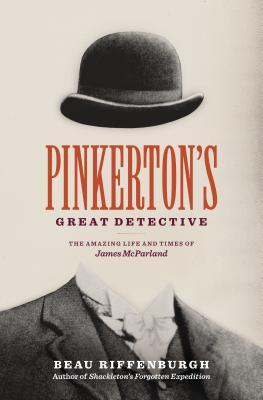Pinkerton’s Great Detective: The Amazing Life and Times of James McParland
- By Beau Riffenburgh
- Viking
- 400 pp.
- Reviewed by Susan Tejada
- January 16, 2014
The Irish immigrant turned private investigator was both idolized and reviled.

Allan Pinkerton desperately needed “no ordinary man.” He had to find one person to meet multiple requirements: a rugged laborer who could work hard and hold his liquor; an Irish-Catholic bachelor willing to take on a false identity as a miner in the anthracite coal fields of Pennsylvania’s Schulykill County and, for months or even years, spy and inform on his fellow miners.
In 1873 Pinkerton, creator of the eponymous national detective agency with the famous motto ”We Never Sleep,” found his man in James McParland. The Irish immigrant had been job-hopping since coming to the United States six years earlier. It wasn’t until he linked up with Pinkerton, however, that McParland discovered his true calling: private investigator.
In Pinkerton’s Great Detective, Beau Riffenburgh looks at McParland’s long history with the agency and attempts to get at the truth behind a controversial man who was alternately idolized as an anti-terrorist crusader and despised as an agent provocateur, stool pigeon and perjurer.
Posing as all-around bad guy James McKenna — counterfeiter, con man and murderer on the lam — McParland headed to the coal fields to infiltrate the Molly Maguires, a secret society accused of revenge murders and sabotage against mining companies. Destruction of the Molly Maguires was the goal of Franklin Gowen, the railroad president and would-be mining titan who hired Pinkerton’s. Going under deep cover among the miners, McParland lived in constant danger of exposure. Riffenburgh effectively portrays the tension that accompanied McParland’s every move, from filing secret reports with his bosses to sitting in on murder conspiracies.
After two and a half years, his cover blown, McParland took the stand to testify against the men — and one of the two women — charged with murder, assault, conspiracy or perjury as a result of Pinkerton’s investigations. The upshot of the Molly Maguire trials, according to the book’s appendix: 59 guilty verdicts, 21 executions and enduring fame for McParland as the “great detective” of the book’s title. For the next three decades, he would remain at Pinkerton’s. But his reputation was based primarily on this early success, as was his notoriety for failing to try to prevent murders he learned of in advance.
Riffenburgh explores in depth the early battles of labor activists and the reliance of business owners on using private armies of law enforcers to bust the unions. This historical context is essential but overly detailed when it comes to secondary events and peripheral characters; certain passages read more like encyclopedia entries than narrative nonfiction.
After the Molly Maguire trials, McParland headed west as superintendent of Pinkerton’s Denver office. The story stalls with reports of labor strikes and McParland’s administrative style, but picks up again with an account of the detective’s last major case: an investigation of the assassination of former Idaho governor Frank Steunenberg near Boise in 1905. Despite McParland’s wily extraction of a confession from the chief suspect, and his masterminding of the questionable extradition from Colorado to Idaho of three other suspects who were leaders of the Western Federation of Miners, none of the leaders was found guilty. At one trial, defense attorney Clarence Darrow witheringly mocked McParland and his methods: “Watching and snaring his fellow-men. Is there any other calling in life can sink to that?”
A word of caution to curious readers of the print version of this book: Keep your computer close at hand. Although the book jacket touts the author’s meticulous research, the extensive endnotes, appendices, bibliography and maps are available only online, at the publisher’s website or the website of author Susanna Gregory (the pen name of Liz Cruwys, Riffenburgh’s wife). Links to the sites are printed, awkwardly, at the front of the book and twice in the text. Exclusion of back matter from the print version is lamentable. It probably could have been avoided with judicious pruning of both text and notes to free up limited space, with the added benefit of tightening up a narrative that drags in spots under the weight of extraneous detail.
Riffenburgh’s efforts to portray McParland in his full human complexity are hindered by gaps in the archival record. True to his training, the private investigator was exceedingly private. He left few personal documents behind, and records from his tenure in Pinkerton’s Denver office disappeared long ago. Was he “in personal intercourse … most agreeable,” as The Seattle Daily Times reported? Or did he have “no more warmth in him than a hangman’s rope,” as novelist Dashiell Hammett described him in a fictionalized portrait?
Trial transcripts and written comments by others, though voluminous, don’t shed light on how McParland himself felt about his work or his personal tribulations, including serious stress-related illnesses and the early deaths of his first wife and young daughter.
McParland will, Riffenburgh concludes, “forever remain an enigma.”
Susan Tejada is the author of In Search of Sacco and Vanzetti: Double Lives, Troubled Times, and the Massachusetts Murder Case That Shook the World, recipient of the Independent Publisher Book Award gold medal for true crime. Previously she was a writer and editor at the National Geographic Society.

